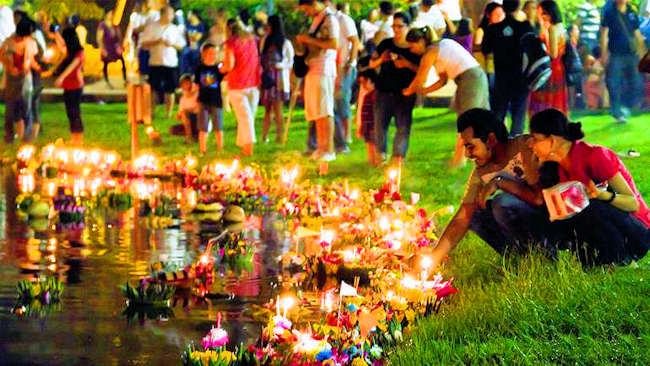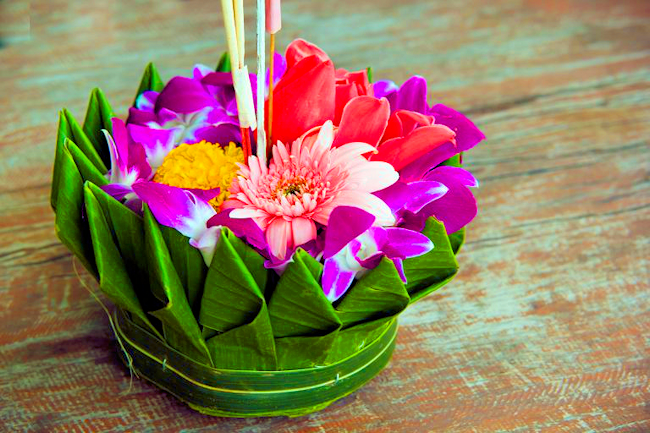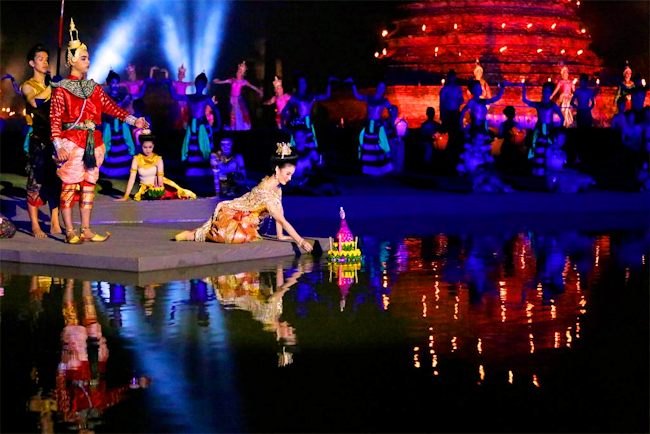Loy Krathong [ลอยกระทง] is one of the biggest festivities in Thailand. It is when people take to the waters to release small, illuminated boat offerings made of banana stalks and leaves. Over the years the sight of lights floating across the country’s rivers and canals has become a point of intrigue for visitors from all over.
The term “Loy Krathong” is derived from word “loy” – meaning “to float”- and the word “krathong” – which refers to type of small, floating religious offering.

The Krathong
Krathongs [กระทง] are usually made out of banana stems and leaves. The stem is cut into a circular shape to form the base of the krathong. Banana leaves are then cut and folded into many rectangular pieces which adorns the outer edges. Lastly, flowers are placed as decorative offerings at the top alongside candles and incense sticks. It is also common for people to place pieces of their hair and nails in the offerings. This is done as a symbolic gesture to float away any bad lucks that one may have. Another common practice is for people to place coins in the krathongs. This is done as an act of charity, for the money will be fished out of the offerings by children the day after the celebration.

The creation of krathongs reflect the longstanding attitudes of respecting and understanding natural materials that are present within the culture of Thai craftsmanship. The banana boat offerings oftentimes demonstrate astonishing skills of crafts and aesthetics. Right before the floating, people will light the candles and incense, then bring the krathongs up to their foreheads. As they do this, they will express words of gratitude and make good wishes for their future.
True to its name, the highlight of the festival is the floating of krathongs across small and large bodies of water all over the country. The objective for this act varies depending on customs and beliefs, but can be generally identified as follow:
- The worship Phra Mae Khongkha
Phra Mae Khongkha is the Thai name for the Hindu goddess Ganga who is the personification of the river Ganges. When the Thai ancestors adopted Hinduism, they blend its teachings with local animistic beliefs. Thus, Ganga became worshipped as Phra Mae Khongkha – the goddess who personifies all bodies of water.
As an agricultural society, water has played a crucial role in the Thai way of living since ancient times. The element provides sustenance, while rivers, canals, and oceans acted as the main mode of transportation throughout the major part of Thai history. Thus, every year during the Loy Krathong festival, Thais float small boats of offerings as tokens of gratitude toward the goddess of water. They also use this opportunity to ask forgiveness for any wrongdoings they have committed upon the water, such as littering or wasteful usage.
- The worship of Lord Buddha
When Prince Siddhartha decided to leave his worldly life behind, he cut off his topknot and adopted an ascetic lifestyle. The topknot was enshrined in a pagoda in the heavens and the prince went on to achieve enlightenment, becoming known as the Lord Buddha. Conveniently, legend also holds that all rivers flow down from the heavens. Thus, Thais float krathongs in rivers and other bodies of water, believing that the offerings will find their way to the heavenly pagoda. Another version of the legend tells that the Lord Buddha once left behind a footprint at the bank of the Nammatha river in India. Thus, Thais float krathongs in belief that the offerings will find their way to the sacred footprint.
- The worship of Venerable Upagupta
Upagupta was a Budhist monk who, according to legend, was a spiritual teacher of the Indian Emperor Ashoka. The venerable master was said to have quelled the demon Mara during a religious celebration held by the emperor. In Myanmar, it is believed that Upagupta is still alive, residing in a recluse at the center of the ocean. This legend was later adopted by the certain parts of Thailand. Krathongs are float, according to this line of faith, as offerings for Upagupta.
- The worship of Lord Vishnu
Another belief with Hindu origins, the god Vishnu is said to be slumbering on a giant serpent in the Ocean. Thus, krathongs are float as offerings to Lord Vishnus, as all water ways lead to the sea.
- The worship of ancestors
Some people also float offerings to pay homage to their ancestors. This line of belief shares common traits with other celebrations such as the East Asian Lantern Festival.
Other Loy Krathong activities include the floating of sky lanterns, Buddhist religious ceremonies, music, street food, and local fairs. Major rivers such as the Chao Phraya and Mekong are hotspots for celebration.
Origins
It is a common belief that Loy Krathong originated from the period of the Sukhothai Kingdom (1238 -1438). The classical literature Tamrap Thao Si Chulalak [ตํารับท้าวศรีจุฬาลักษณ์] tells of lady named Nang Noppamas who was a high-ranking concubine of the King of Sukhothai. During an annual celebration where royals offered votive floats in worship of the Buddha, Nang Noppamas designed an elegant float shaped like a lotus and decorated with miniature bird figures. This float eventually became the basis for the krathong. The story also inspired another common tradition of Loy Krathong: beauty pageants where contestants dress up as Nang Noppamas.



